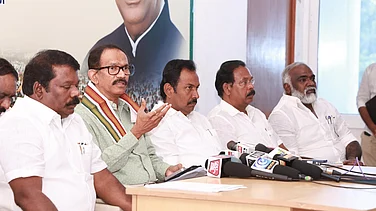On February 6, the news of the 7.8 magnitude earthquake in Turkey-Syria jolted the world. The movement of tectonic plates by the complex interaction between the African, Arabian, and Eurasian tectonic plates and the Anatolian tectonic block is supposedly the reason for such a shallow earthquake. Around 50,000 people have died so far and the bodies are still being recovered. Meanwhile, it’s time we remind ourselves once more – earthquakes do not kill people; buildings do.
Amidst a flood of heart-rending stories and visuals, there is the story of a small town, Erzin, which did not collapse. Here, no loss of life was reported - thanks to the successive mayors and their council that did not allow any violations in the building designs during construction. Also, hats off to the planners and the designers who could design with erudite mapping of the geography and thus could save thousands of lives.
Lessons for the Himalayan region
The Himalayas are the youngest range of mountains in the world and are still in the formative stage. The plate movements between the Indian and Eurasian plates continue to keep the entire region from Kashmir to North East in seismic zone IV and V. This means that the entire Himalayas are extremely vulnerable to natural disasters like earthquakes and landslides.
The Kangra quake in 1905 in Himachal Pradesh killed nearly 20,000 people. Since then there have been several instances of medium and small-intensity earthquakes in the Himalayan region. The Nepal earthquake in 2015 killed around 9,000 people. The incidence of these earthquakes is increasing and the adaptation strategies mainly flowing from the development models across the region are just inept to mitigate the loss.
Two major river basins, Gangetic and the Indus are situated in this region. These areas also carry the civilization marks of different migrations that have taken place here. In the Indian context and to some extent even in Nepal and Bhutan, there is a push for large-scale hydropower generation. Alone in Himachal Pradesh, there is supposedly a capacity of 30,000 MW. Post-1990s, the development models across India are growth-oriented. The binary of discussion between growth and development is old and now quite stale. This continues to haunt the developmental trajectory. Whether one wants electricity at home, should tourism prosper, ways of employment generation, etc., and then should there not be hydropower projects, the char dham yatra, and so on, continues to be the dissuasion paradigm.
The push from the 1990s from the Centre was and continues to be guided by one single principle, and that is growth. The states, particularly the newly formed ones and even those that were formed earlier, were pushed to attract investments and create employments, and thus meet the fiscal deficit demands. They were asked to look for avenues.
Three major areas for such growth include hydropower projects, cement plants, and tourism. Even the multilateral agencies pumped in huge liquidity in the market for easy access to infrastructure building. And thus began the story of development/growth in the Himalayan region.
Most of these hydropower projects are 'run on the river dam technology', where water is diverted from the main river and run through a long tunnel under the mountains and thus power generation takes place after creating a potential difference at a surge shaft over the turbines. Massive disruption of the mountains takes place and has a triggering effect.
Already we have seen the story of Joshimath in Uttarakhand where the entire township may have to be relocated. But this is not an isolated example; in Himachal, more than half a dozen settlements including Nathpa, Kadahar, Urni, Meeru have borne the brunt of complete displacement.
The manner in which the hydropower projects have been constructed is also another disaster in the offing. The entire muck excavated from the tunnels, or whilst constructing the dams and the powerhouses, stands dumped along the river banks. Just a small jolt is enough to trigger a cascading effect in the entire river stretch. There are studies that prove that even the construction of dams is leading to earthquakes. So, it is not just natural but also ‘man-made’.
Building design on the mountains is important
Let us have a look at the way the buildings have been designed on the mountains. There is a misnomer across the spectrum and even amongst the mountain communities that what the British left has been destroyed by our native rulers, post-independence.
This is inadvertently incorrect. Why? Because the native communities hardly knew how to live on mountains and hilltops. They used to practice migration; come summers and they would move to the top with their cattle and plough and in winters move to the valley. The weather was a big constraint. Hence, all the pre-British settlements or small townships are found in the valleys along the rivers.
However, the British taught the art and science of sustaining on the mountaintop with their engineering skills. The big buildings, for example in Shimla, which was the summer capital of India, were built by them. Even the typologies of construction were enforced with colonial design. There is Gothic, Tudor, and Victorian design; however, no mountain design suited to climate adaptation was developed in the region.
So now after more than 3 quarters of independence, the mountains that had some restrictions in the building were also diluted and the copy-paste models of the plains were created. The jargon of FAR (floor area ratio) depending upon the size of the plot was the driving force and some of the cities and towns even went ahead for real estate development in such towns. This meant more liberal space for vertical growth without having any profound study done of the rock or any geological support for such construction. This has led to a completely moribund growth that has created ugly structures and is extremely vulnerable. What to speak about the general people, the Himachal Pradesh High Court building is an eye reckoner. The building is more than 12-storeyed and is one of the worst mountain architecture typologies.
In a study conducted during the term when I was serving as the deputy mayor of Shimla, called the HVRA (Hazard Vulnerability Risk Assessment), it was estimated that an earthquake striking during day hours would kill more than 15,000 people and during the night would kill nearly 25,000. The entire Himalayan region, unfortunately, showcases such developmental modes. Disasters are not taking place because of ‘unplanned development,’ but rather inversely because of ‘planned development’.
Likewise, the widening of roads, cutting down of mountains, and expanding the national highways in the mountains, particularly the char dham yatra road, are all reminders of a basic fault line. And the fault line is “do we need the mobility of cars, motorized transport, or mobility of the people.”
What needs to be done?
The model has to be inversed immediately. That does not mean that no development must take place. But why for mitigating the thirst of Delhi residents, a dam should be constructed in Renuka in Himachal Pradesh engulfing large tracts of land and forest and robbing the livelihoods of the people? We have to think otherwise.
First and foremost, the development model must include the active participation of the people and give them the power even to veto in case they do not want a hydropower or a cement plant in the neighbourhood. Such a provision was there in the state of Himachal Pradesh where a no-objection certificate was required from the gram panchayat for constructing a hydropower plant. Else, what is going to happen is like what is happening in the tribal district of Kinnaur where a movement called “no means no” has taken the space and is now not allowing a single new hydropower project to be constructed.
Second, support the state governments in the Himalayas with strong fiscal stimulus and compensate them for not allowing large dams, hydropower projects, and so on.
Third, create a mountain forum where dialogue between mountain people in the Himalayas could take place regularly and their suggestions must be paid heed to. Simultaneously ensure that a mountain typology of construction is created unlike the copy-paste models of the plains using the master plan formula. Even in the Himalayan region, there is immense diversity-the Ladakh region is a dry desert and requires a different typology than towns and cities like Mussoorie and Shimla.
Fourth, the creation of infrastructure should be mainstreamed with the climate action plans, of the respective states and local bodies. No infrastructure development should be bypassing such plans. There should be an integration of various service departments while doing so.
Fifth, invest massively in capacity building of the residents and governments. Since we know that earthquakes are bound to happen, the capacity of the native communities to adaptation must be taken as a regular course right from the elementary levels of education. The local bodies must be strengthened in this role, which at the current period are extremely asphyxiated of resources and finances.
Sixth, people must be at the centre of every conservation. No development plans must be implemented without their active participation. The people must own the development strategy and the trajectory unlike the current model of ‘consultant-driven development’, which is neither sustainable nor desirable.
(The author is a columnist, CPI(M) leader and former deputy mayor of Shimla)





















